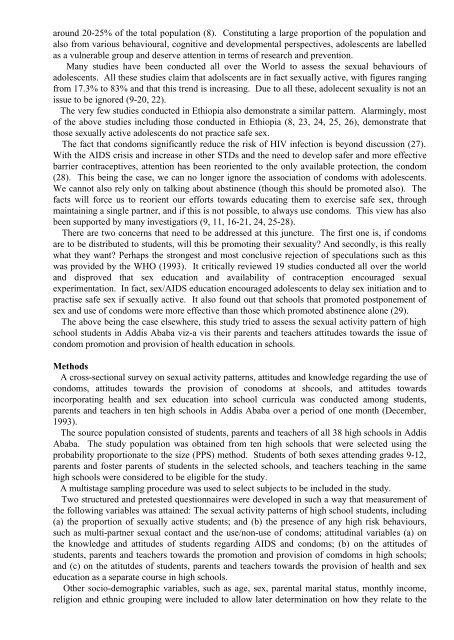Original article - Ethiopian Review
Original article - Ethiopian Review
Original article - Ethiopian Review
- No tags were found...
You also want an ePaper? Increase the reach of your titles
YUMPU automatically turns print PDFs into web optimized ePapers that Google loves.
around 20-25% of the total population (8). Constituting a large proportion of the population andalso from various behavioural, cognitive and developmental perspectives, adolescents are labelledas a vulnerable group and deserve attention in terms of research and prevention.Many studies have been conducted all over the World to assess the sexual behaviours ofadolescents. All these studies claim that adolscents are in fact sexually active, with figures rangingfrom 17.3% to 83% and that this trend is increasing. Due to all these, adolecent sexuality is not anissue to be ignored (9-20, 22).The very few studies conducted in Ethiopia also demonstrate a similar pattern. Alarmingly, mostof the above studies including those conducted in Ethiopia (8, 23, 24, 25, 26), demonstrate thatthose sexually active adolescents do not practice safe sex.The fact that condoms significantly reduce the risk of HIV infection is beyond discussion (27).With the AIDS crisis and increase in other STDs and the need to develop safer and more effectivebarrier contraceptives, attention has been reoriented to the only available protection, the condom(28). This being the case, we can no longer ignore the association of condoms with adolescents.We cannot also rely only on talking about abstinence (though this should be promoted also). Thefacts will force us to reorient our efforts towards educating them to exercise safe sex, throughmaintaining a single partner, and if this is not possible, to always use condoms. This view has alsobeen supported by many investigatiors (9, 11, 16-21, 24, 25-28).There are two concerns that need to be addressed at this juncture. The first one is, if condomsare to be distributed to students, will this be promoting their sexuality? And secondly, is this reallywhat they want? Perhaps the strongest and most conclusive rejection of speculations such as thiswas provided by the WHO (1993). It critically reviewed 19 studies conducted all over the worldand disproved that sex education and availability of contraception encouraged sexualexperimentation. In fact, sex/AIDS education encouraged adolescents to delay sex initiation and topractise safe sex if sexually active. It also found out that schools that promoted postponement ofsex and use of condoms were more effective than those which promoted abstinence alone (29).The above being the case elsewhere, this study tried to assess the sexual activity pattern of highschool students in Addis Ababa viz-a vis their parents and teachers attitudes towards the issue ofcondom promotion and provision of health education in schools.MethodsA cross-sectional survey on sexual activity patterns, attitudes and knowledge regarding the use ofcondoms, attitudes towards the provision of conodoms at shcools, and attitudes towardsincorporating health and sex education into school curricula was conducted among students,parents and teachers in ten high schools in Addis Ababa over a period of one month (December,1993).The source population consisted of students, parents and teachers of all 38 high schools in AddisAbaba. The study population was obtained from ten high schools that were selected using theprobability proportionate to the size (PPS) method. Students of both sexes attending grades 9-12,parents and foster parents of students in the selected schools, and teachers teaching in the samehigh schools were considered to be eligible for the study.A multistage sampling procedure was used to select subjects to be included in the study.Two structured and pretested questionnaires were developed in such a way that measurement ofthe following variables was attained: The sexual activity patterns of high school students, including(a) the proportion of sexually active students; and (b) the presence of any high risk behaviours,such as multi-partner sexual contact and the use/non-use of condoms; attitudinal variables (a) onthe knowledge and attitudes of students regarding AIDS and condoms; (b) on the attitudes ofstudents, parents and teachers towards the promotion and provision of comdoms in high schools;and (c) on the atitutdes of students, parents and teachers towards the provision of health and sexeducation as a separate course in high schools.Other socio-demographic variables, such as age, sex, parental marital status, monthly income,religion and ethnic grouping were included to allow later determination on how they relate to the




![to read the full report [pdf, Amharic] - Ethiopian Review](https://img.yumpu.com/52737829/1/190x245/to-read-the-full-report-pdf-amharic-ethiopian-review.jpg?quality=85)











